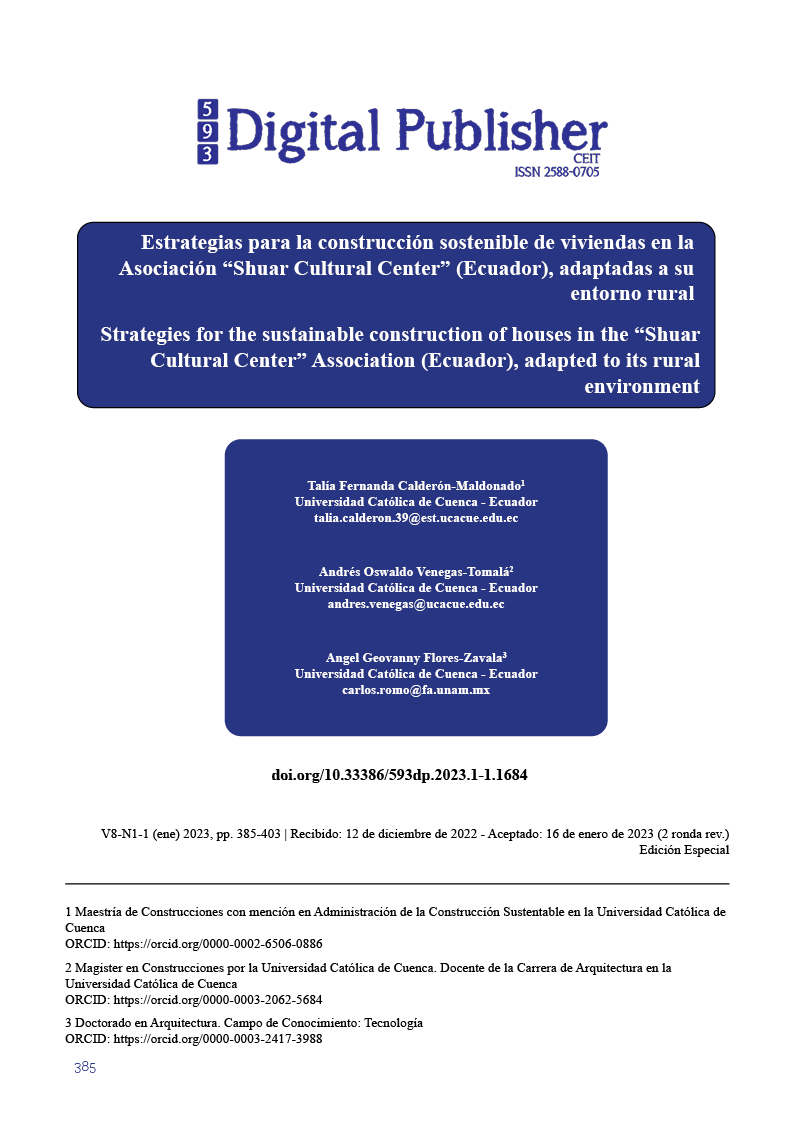Strategies for the sustainable construction of houses in the “Shuar Cultural Center” Association (Ecuador), adapted to its rural environment
Main Article Content
Abstract
This article seeks to generate strategies for the sustainable construction of housing for the members of the Shuar Cultural Center Association; from the identification of materials and construction methods used in the Shuar settlements of the Francisco de Orellana Canton, the analysis of the local climate and the sociocultural perception of the inhabitants. Methodology. The research is of the Pure Basic type, its level is descriptive and explanatory. It addresses the problem of study through documentary research, systematic data collection, and climatological analysis. Results are presented with a qualitative and quantitative approach through the application of 2 research instruments: observation sheet and survey. Results. The typologies of constructions and the materials identified in the Shuar settlements are described, and the results of the socio-cultural perception surveys of the owners of the evaluated houses and of the partners are presented. With this background and the characteristics of the local climate, as well as the stereographic projection, passive bioclimatic strategies are proposed, and a construction system adapted to the availability of materials and the conditions of the rural environment of the site is outlined. Conclusion The passive bioclimatic strategies and the construction system include contemporary and vernacular materials that respond to the needs of comfort, adaptation to the climate, and the Shuar cultural manifestation.
Downloads
Article Details

This work is licensed under a Creative Commons Attribution-NonCommercial-ShareAlike 4.0 International License.
1. Derechos de autor
Las obras que se publican en 593 Digital Publisher CEIT están sujetas a los siguientes términos:
1.1. 593 Digital Publisher CEIT, conserva los derechos patrimoniales (copyright) de las obras publicadas, favorece y permite la reutilización de las mismas bajo la licencia Licencia Creative Commons 4.0 de Reconocimiento-NoComercial-CompartirIgual 4.0, por lo cual se pueden copiar, usar, difundir, transmitir y exponer públicamente, siempre que:
1.1.a. Se cite la autoría y fuente original de su publicación (revista, editorial, URL).
1.1.b. No se usen para fines comerciales u onerosos.
1.1.c. Se mencione la existencia y especificaciones de esta licencia de uso.
References
Abidin, N. Z., & Pasquire, C. L. (2005). Delivering sustainability through value management: Concept and performance overview. In Engineering, Construction and Architectural Management (Vol. 12, Issue 2, pp. 168–180). https://doi.org/10.1108/09699980510584502
Bayona, D. (2018). CASA: planificando ciudades sostenibles y resilientes en la Amazonía | Plataforma Arquitectura. Plataforma Arquitectura. https://www.plataformaarquitectura.cl/cl/902105/casa-planificando-ciudades-sostenibles-y-resilientes-en-la-amazonia
Chambers, R., & Conway, G. R. (1992). Sustainable rural livelihoods: practical concepts for the 21st century. IDS Discussion Paper, 296.
Del Rio, O. (2011). El proceso de investigación : etapas y planificación de la investigación. La Investigación En Comunicación. Métodos y Técnicas En La Era Digital, January 2011, 67-93.https://www.academia.edu/2443422/EL_PROCESO_DE_INVESTIGACION_ETAPAS_Y_PLANIFICACION_DE_LA_INVESTIGACION_EN_COMUNICACION
Durukan, A., Beşir, Ş. E., Altuntaş, S. K., & Açıkel, M. (2021). Evaluation of sustainability principles in adaptable re-functioning: Traditional residences in demirel complex. Sustainability (Switzerland), 13(5), 1–23. https://doi.org/10.3390/su13052514
Gnerre, M. (2014). Los salesianos y los shuar. Construyendo la identidad cultural. La Presencia Salesiana, 556–628. https://core.ac.uk/download/pdf/84694606.pdf
GADPO,.(2020).Plan de Desarrollo y Ordenamiento Territorial de la Provincia de Orellana https://www.gporellana.gob.ec/resources/uploads/desarrollo/2020/ORDENANZA-Y ACTUALIZACI%C3%93N-PDOT_INCLUYE-POST-PANDEMIA FUSIONADO_compressed.pdf
ICOMOS Built Vernacular Heritage. (1999). ICOMOS Charter on the Built Vernacular Heritage. October, October. http://www.international.icomos.org
Herrera Iliana. (2008). La vivienda shuar al suoriente ecuatoriano,2008. https://ru.dgb.unam.mx/handle/DGB_UNAM/TES01000642796
JUNAC. (1988). Manual de diseño para maderas del grupo andino (PADT-REFOR). https://www.comunidadandina.org/biblioteca-andinoteca/manual-de-diseno-para-maderas-del-grupo-andino/
Minchala Diego. (2017). Rediseño arquitectónico en la vivienda rural tipo, construida por el ministerio de desarrollo urbano y vivienda (miduvi), en la Comunidad el Kiim, ParroquiaLa Paz, Cantón Yacuambi en la Provincia de Zamora Chinchipe, basado en los saberes ancestrales de diseño de viviendas shuar. https://fdocuments.ec/document/universidad-internacional-del-ecuador-sede-loja vivienda-miduvi-en-la-comunidad.html?page=1
NEC. (2015). Norma Ecuatoriana de la Construcción; Capítulo Estructuras de Madera. https://www.habitatyvivienda.gob.ec/wp-content/uploads/downloads/2015/02/NEC-SE-MD-Estructuras-Madera.pdf
Philokyprou, M., Michael, A., Malaktou, E., & Savvides, A. (2017a). Environmentally responsive design in Eastern Mediterranean. The case of vernacular architecture in the coastal, lowland and mountainous regions of Cyprus. Building and Environment, 111, 91–109. https://doi.org/10.1016/j.buildenv.2016.10.010
Philokyprou, M., Michael, A., Malaktou, E., & Savvides, A. (2017b). Environmentally responsive design in Eastern Mediterranean. The case of vernacular architecture in the coastal, lowland and mountainous regions of Cyprus. Building and Environment, 111, 91–109. https://doi.org/10.1016/j.buildenv.2016.10.010
Rodríguez María. (2020). Estudio de los sistemas constructivos de vivienda delas nacionalidades indígenas shuar y achuar, de laprovincia de pastaza; para el desarrollo de un manualtécnico constructivo aplicado a un prototipo devivienda comunitaria. Febrero,2020. https://repositorio.uti.edu.ec/handle/123456789/1654
Rolando Fournier Zepeda. (2008). Construcción sostenible y madera: realidades, mitos y oportunidades. Tecnologia En Marcha, 21(2), 92–101. file:///Users/paulinavalenzuela/Downloads/Dialnet-ConstruccionSostenibleYMadera-4835621.pdf
San Sebastián, M., & Hurtig, A. K. (2004). Oil exploitation in the Amazon basin of Ecuador: A public health emergency. Revista Panamericana de Salud Publica/Pan American Journal of Public Health, 15(3), 205–211. https://doi.org/10.1590/S1020-49892004000300014
Udrea, I., Croitoru, C., Nastase, I., Crutescu, R., & Badescu, V. (2016). Thermal Comfort in a Romanian Passive House. Preliminary Results. Energy Procedia, 85, 575–583. https://doi.org/10.1016/j.egypro.2015.12.247




